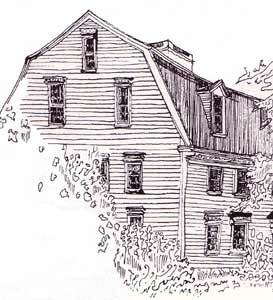 The sea mist rolls in across the town in the early morning hours. The residents are beginning to stir and awake to begin a new day. At the end of the road closest to the dock sits the old Captains House. A majestic yet simple colonial building that seems to manifest the calm, terrible beauty of the sea. In the summer the sun hits the white washed fence reflecting the perfectly manicured structure. In the fall, auburns, reds, yellows, and browns dress the old wooden frame. In the winter the shingles creek under the weight of ice and snow, shimmering like a palace of diamond. And as spring creeps back into the sleepy New England harbor the Captain’s House comes alive once more with the vibrancy of bright greens, pinks, and periwinkle. Indeed, the Captain’s House is a pillar of majesty though all times of year.
The sea mist rolls in across the town in the early morning hours. The residents are beginning to stir and awake to begin a new day. At the end of the road closest to the dock sits the old Captains House. A majestic yet simple colonial building that seems to manifest the calm, terrible beauty of the sea. In the summer the sun hits the white washed fence reflecting the perfectly manicured structure. In the fall, auburns, reds, yellows, and browns dress the old wooden frame. In the winter the shingles creek under the weight of ice and snow, shimmering like a palace of diamond. And as spring creeps back into the sleepy New England harbor the Captain’s House comes alive once more with the vibrancy of bright greens, pinks, and periwinkle. Indeed, the Captain’s House is a pillar of majesty though all times of year.
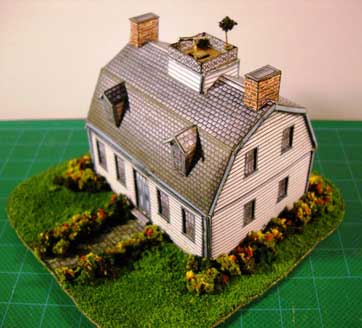 Building the Fiddlersgreen Captain's House: By Jay Massey Building the Fiddlersgreen Captain's House: By Jay Massey
I got started on the Captains' House model from the New England Village set the other day and due to things happening at the salt mine had to drag it out a bit longer than it really should have taken. It is actually a pretty straightforward and easy one to build. I got started by printing out multiple copies to be able to use the extra parts to give it a bit more depth to some parts. This is the basic kit once the parts are cut out.
It also has a white picket fence to go around the perimeter of the base, but I chose not to use it instead landscaping the base for it to fit into my upcoming rail road layout. Since I like to add some relief to these things, I used three copies of the front and rear of the house to start with. To use them I cut out the window and door openings in two of 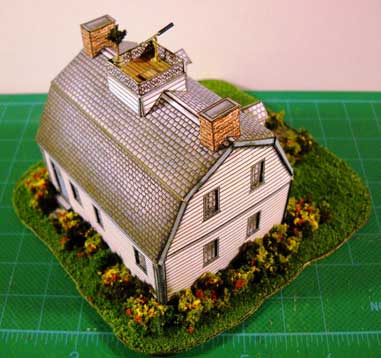 each copy like so. each copy like so.
Now if you tried to just make a sandwich out of the front and rear parts you would soon wind up with a rather thick bit of card to try and fold up and glue together. You would also be shortchanging yourself on a few other parts that go a long way to bettering the look of the finished project. I cut the parts out that I actually needed around the windows and doors and frames to create my little bit of illusion. The front comes out like so.
Gluing and aligning the main parts makes two main parts that you can handle bending tabs on but still gives them a lot more depth. As you can see in the next shot, I have also added the steps that were cut out from the sliced and diced printouts as well as the corner boards. These will be applied after gluing things together. By having recessed as well as exterior parts you have more layers on the model to make it look a bit more 3D. To make it appear even deeper for all the recessed parts I edge colored all the cut parts with some marker pens so no white card would be showing through here and there.
From this point it is a lot more bending of tabs, aligning parts and gluing stuff together. The boards that go on the corners of the building were folded and applied once things were together. I used some scrap card to make a lip to glue the horizontal part of the front and rear step to then some more to add the vertical part of the step. The location of these are printed on the front and rear just under the door frames.
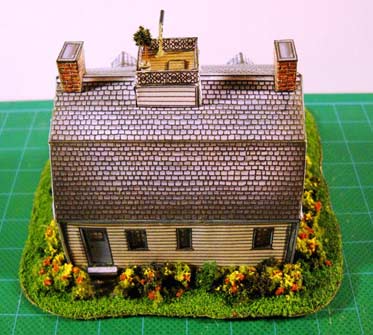 When I started this one I was fascinated by the widows' walk on the roof. In case you aren't familiar with what a widows' walk is, it is basically a platform built on the roof of the house so that the Captains' wife cold look out on the ocean to see when her hubbys' ship returned. Since long ocean voyages in the old days were somewhat problematic as far as actually having crews returning, the roof walk got the name Widows' Walk. The one on this model had a hatch printed on it and I used a couple of the copies to add some more dimension to that part but I also added a couple more things that were often featured up there from stories that I have read about them. The wrought iron safety fence around the walk itself got doubled so that it had an inside and outside. Since this pretty well negated the need for a tab, I just cut it off and end glued the ends together. When I started this one I was fascinated by the widows' walk on the roof. In case you aren't familiar with what a widows' walk is, it is basically a platform built on the roof of the house so that the Captains' wife cold look out on the ocean to see when her hubbys' ship returned. Since long ocean voyages in the old days were somewhat problematic as far as actually having crews returning, the roof walk got the name Widows' Walk. The one on this model had a hatch printed on it and I used a couple of the copies to add some more dimension to that part but I also added a couple more things that were often featured up there from stories that I have read about them. The wrought iron safety fence around the walk itself got doubled so that it had an inside and outside. Since this pretty well negated the need for a tab, I just cut it off and end glued the ends together.
A telescope was often a part of these things to enable the lady of the house to scan the horizon for that first glimpse of the homeward bound ship. Also a small tree in a pot was planted up there to give the lady another reason to climb her way to the roof as well as a way to measure the time that it took for her beloved to return from his long voyage. It also proved to the captain that his lady had indeed spent her time looking for his return.
I used a spare brass machine gun barrel from some of my PE ship parts to act as the upright support, a staple cut and bent as the telescopes' mounting and (I know I will probably hear from possm) a bit of styrene tube and stretched sprue to make the telescope itself with a little painting for detail. To make the potted tree I started with a bit of stretched sprue chucked into a motor tool to spin it and a hobby knife to trim it to give it a bit of shape like an old milk can. The tree itself is another bit of stretched sprue with some landscaping material glued to the top to look like a young growing tree.
The base was made up from three of the printouts to form a thick enough part to take the glue and make it a bit thicker without deforming. I sprayed on some diluted white glue overall then added some fine green turf material for the grass. I cleared of the front and rear stone walk detail with a Q tip before it dried so these parts would show through. After the lawn had dried I added the house and then started using some more coarse landscaping material to form the bushes lining the walkway and around the house. Some more material was chopped up fine while the glue set on the bushes and then a second spray of the diluted white glue let me add the flowers to make it look like things were happening in the spring time. A final overall spray of the diluted white glue fixed everything in place so it wouldn't shed over time and I had my project done.
|
| Jay Massey is an avid cardmodeler living and working in the LasVegas area where there are few trees. |
A brief history about Whaling:
Whaling has been linked to human beings from the 9th Century in which the Basques seemed to have crossed the Atlantic to hunt whales close to the New England coast (they were the only ones whaling in this 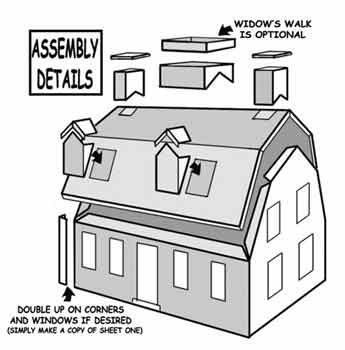 coast), driving to extinction the gray whale.
coast), driving to extinction the gray whale.
The whaling industry started in the New England US coast in the 1700s, and lasted until the l930s. Among all whaling ports in the east coast of the US, those in Cape Cod were the more fructiferous in this industry, and initially most captures were done in this area.
Places in Massachusetts like Nantucket, Martha’s Vineyard, Barnstable, or Dartmouth (later New Bedford) were the most important ones although other ports like Newport, RI, Providence, Connecticut, or Long Island, NY, were also important whaling ports.
It seems that the Basques were the first commercial whalers, many years before the industry of whaling spread all over the world. Between the 9th Century and the 16th Century, and following the Basques, many other Europeans visited Greenland waters were the most visited ones for whaling. Although there were whalers from other European countries, most were Dutch. They used to take the whales to Rotterdam to have their blubber processed in facilities called "cookeries." During those centuries, the Dutch processed whale oil for the whole Europe.
Since the arrival of the Pilgrims, whaling, although primitive (they used small scallops with an harpooner in the front) and individualistic (whale 2 products were only exchangeable among them), was a very profitable resource as energy oil, for betty lamps, and to maintain leather (this whale oil was called "train oil," and soon would become an article for export).
The whaling industry in the States started in Buzzards Bay. By 1740 Buzzards Bay had only small farming settlements, being the largest one Acushnet (named after the local river), and, during the second half of the 1700s the Russell’s, a well known family of the area, established the first small whaling business, in New Bedford.
There were a lot of whales in the New England coast and the Royal Charter of England had previously guaranteed the Pilgrims, which they could enjoy free fishing. That is why they proceeded to make the first regulation on whaling in the US. For instance, those whales arriving to the coast by themselves (wounded or stranded) could not be touched until the General Court inspected them. This General Court must also inspect the scars on those whales abandoned, wounded, or dead by the whalers. Before the authorities arrival the whale could not be cut, then it would be established who could profit from that whale, the one who first discovered it, or the whaler who had wounded it.
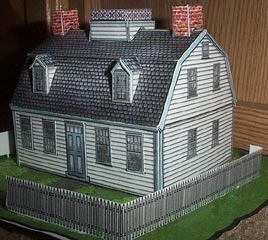 |
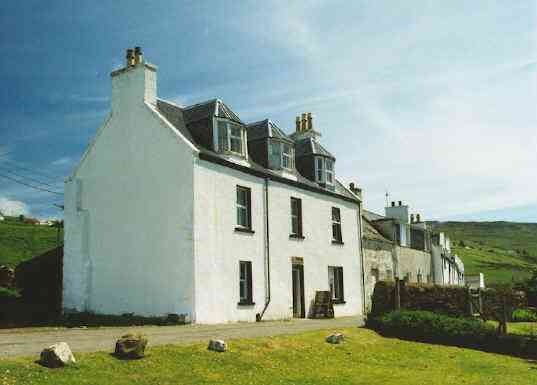 |
This is the Captain's House model showing the included layout and picket fence. |
The Captains House sitting proudly alongside the Irish Bay |
A short Whaling History:
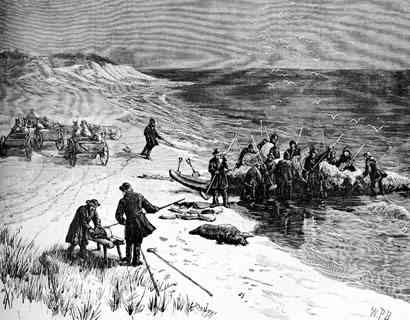
Shore Whaling in the North East- the earliest method |
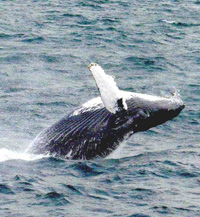
A Whale at play |
|
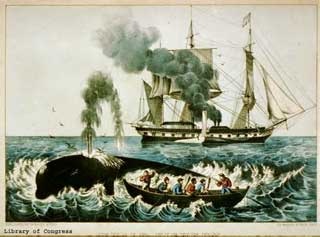
The Narragansett 'Sleighride in pictures |
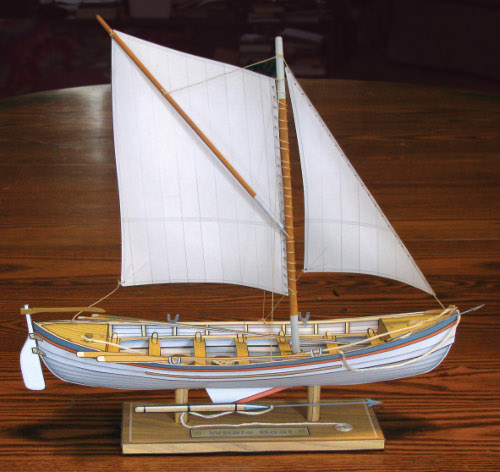
Also in our collection is the Whale Boat designed by Richard Dery



 The sea mist rolls in across the town in the early morning hours. The residents are beginning to stir and awake to begin a new day. At the end of the road closest to the dock sits the old Captains House. A majestic yet simple colonial building that seems to manifest the calm, terrible beauty of the sea. In the summer the sun hits the white washed fence reflecting the perfectly manicured structure. In the fall, auburns, reds, yellows, and browns dress the old wooden frame. In the winter the shingles creek under the weight of ice and snow, shimmering like a palace of diamond. And as spring creeps back into the sleepy New England harbor the Captain’s House comes alive once more with the vibrancy of bright greens, pinks, and periwinkle. Indeed, the Captain’s House is a pillar of majesty though all times of year.
The sea mist rolls in across the town in the early morning hours. The residents are beginning to stir and awake to begin a new day. At the end of the road closest to the dock sits the old Captains House. A majestic yet simple colonial building that seems to manifest the calm, terrible beauty of the sea. In the summer the sun hits the white washed fence reflecting the perfectly manicured structure. In the fall, auburns, reds, yellows, and browns dress the old wooden frame. In the winter the shingles creek under the weight of ice and snow, shimmering like a palace of diamond. And as spring creeps back into the sleepy New England harbor the Captain’s House comes alive once more with the vibrancy of bright greens, pinks, and periwinkle. Indeed, the Captain’s House is a pillar of majesty though all times of year.  coast), driving to extinction the gray whale.
coast), driving to extinction the gray whale. 



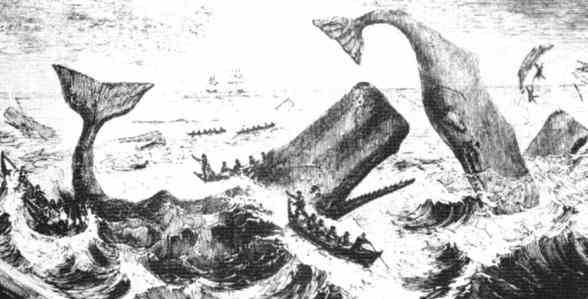





 Building the Fiddlersgreen Captain's House:
Building the Fiddlersgreen Captain's House: each copy like so.
each copy like so. When I started this one I was fascinated by the widows' walk on the roof. In case you aren't familiar with what a widows' walk is, it is basically a platform built on the roof of the house so that the Captains' wife cold look out on the ocean to see when her hubbys' ship returned. Since long ocean voyages in the old days were somewhat problematic as far as actually having crews returning, the roof walk got the name Widows' Walk. The one on this model had a hatch printed on it and I used a couple of the copies to add some more dimension to that part but I also added a couple more things that were often featured up there from stories that I have read about them. The wrought iron safety fence around the walk itself got doubled so that it had an inside and outside. Since this pretty well negated the need for a tab, I just cut it off and end glued the ends together.
When I started this one I was fascinated by the widows' walk on the roof. In case you aren't familiar with what a widows' walk is, it is basically a platform built on the roof of the house so that the Captains' wife cold look out on the ocean to see when her hubbys' ship returned. Since long ocean voyages in the old days were somewhat problematic as far as actually having crews returning, the roof walk got the name Widows' Walk. The one on this model had a hatch printed on it and I used a couple of the copies to add some more dimension to that part but I also added a couple more things that were often featured up there from stories that I have read about them. The wrought iron safety fence around the walk itself got doubled so that it had an inside and outside. Since this pretty well negated the need for a tab, I just cut it off and end glued the ends together.